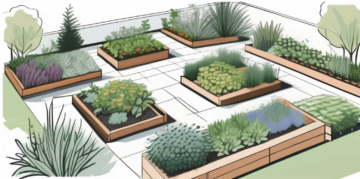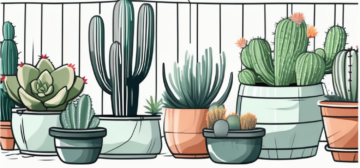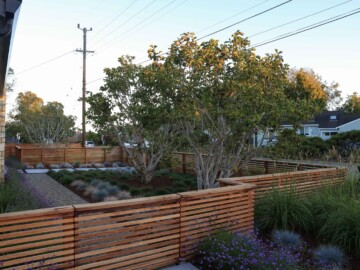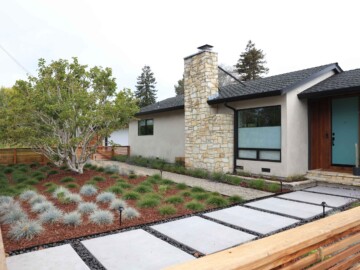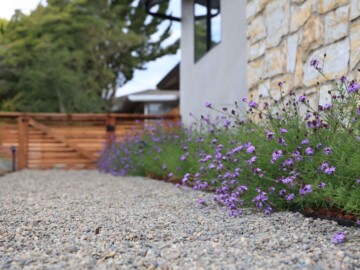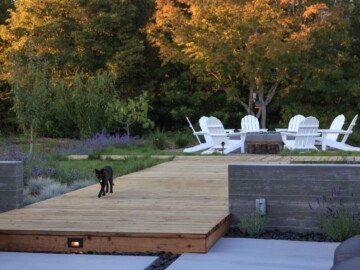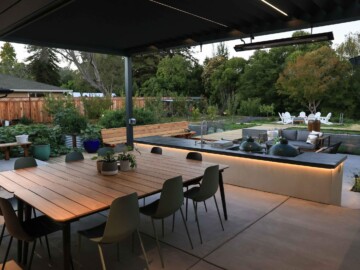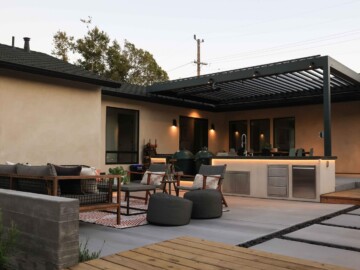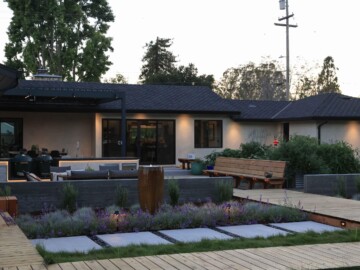Craft an Edible Garden Design with 4 Secrets from an Experienced Landscape Professional
In this article, we will explore the secrets to crafting an edible garden design that will not only be aesthetically pleasing but also provide bountiful harvests of delicious, homegrown produce. These secrets have been shared by an experienced landscape professional who has mastered the art of edible garden design. By implementing these secrets, you can create a sustainable and thriving garden that will bring joy and nourishment to your life.
Understanding the Basics of Edible Garden Design
Before diving into the secrets, it is crucial to have a strong foundation in understanding the basics of edible garden design. One essential aspect is soil quality.
Creating a thriving edible garden involves more than just planting seeds and watering them. It requires a deep understanding of the ecosystem you are trying to cultivate. By focusing on soil quality, you are setting the stage for a successful harvest. Healthy soil is teeming with beneficial microorganisms that help plants absorb nutrients efficiently, leading to robust growth and bountiful yields.
The Importance of Soil Quality
The quality of your soil plays a vital role in the success of your garden. It is important to ensure that your soil is rich in nutrients and has the right texture for plants to thrive. Conduct a soil test to assess its pH level and nutrient content and make any necessary amendments to improve its quality.
Understanding the composition of your soil can help you select the right plants for your garden. Some plants thrive in well-draining sandy soil, while others prefer the moisture-retaining properties of loamy soil. By tailoring your plant selection to your soil type, you can create a harmonious environment where each species can flourish.
Choosing the Right Location for Your Garden
The location of your edible garden is equally significant. Select a spot that receives at least six hours of sunlight each day and provides good drainage. Consider the proximity to your water source and accessibility for regular maintenance.
In addition to sunlight and water access, think about the microclimates within your garden space. Areas near walls or fences may create warm microclimates, ideal for heat-loving plants, while low-lying spots might be prone to frost pockets. By observing these nuances in your garden, you can strategically place your plants to optimize their growth and resilience to environmental stressors.
Secret 1: Incorporating Permaculture Principles
Permaculture principles are the foundation of sustainable garden design. Understanding and incorporating these principles will significantly enhance the productivity and resilience of your garden.
One key aspect of permaculture is the emphasis on observing and interacting with nature. By closely observing how natural ecosystems function, gardeners can learn valuable lessons on how to work with, rather than against, the natural environment. This approach helps in creating gardens that are not only productive but also in harmony with the surrounding ecosystem.
The Basics of Permaculture
Permaculture is a design philosophy that aims to create sustainable and self-sufficient ecosystems. It involves mimicking natural patterns and processes to create a harmonious and productive garden.
Central to permaculture design is the concept of zones, which are areas within the garden that are grouped based on the frequency of human interaction and maintenance required. By strategically placing plants and elements based on these zones, gardeners can optimize their time and energy while maximizing the benefits of their garden.
Benefits of Permaculture in Edible Gardens
When applied to edible garden design, permaculture principles promote biodiversity, conserve water, and minimize the need for synthetic inputs. This results in healthier plants and higher yields with less effort.
Permaculture encourages the use of companion planting, where mutually beneficial plant combinations are grown together. This practice not only helps in pest control and nutrient cycling but also fosters a more resilient and diverse ecosystem. By harnessing the power of these natural relationships, gardeners can create thriving edible gardens that are not only productive but also ecologically sustainable.
Secret 2: Utilizing Companion Planting
Companion planting is a technique that involves planting compatible plants together to enhance growth, deter pests, and maximize space utilization.
Companion planting is a fascinating and age-old practice that has been utilized by gardeners for centuries to create harmonious and mutually beneficial plant communities. By strategically pairing certain plants together, you can harness the power of nature to improve the health and productivity of your garden.
What is Companion Planting?
Companion planting is the practice of growing certain plants in close proximity to benefit one another. Some plants repel pests, while others attract beneficial insects or provide shade and support to neighboring plants. For example, planting marigolds alongside tomatoes can help deter nematodes, while interplanting basil with tomatoes can enhance the flavor of the fruit.
Companion planting is not only limited to vegetables but can also be extended to flowers and herbs. For instance, planting dill near cucumbers can attract predatory insects that feed on common cucumber pests, thus reducing the need for chemical pesticides.
How to Choose Companion Plants
When selecting companion plants, consider their compatibility in terms of nutrient needs, growth habits, and pest resistance. Research which plants have mutually beneficial relationships and plan your garden accordingly. By understanding the unique characteristics of each plant species, you can create a diverse and resilient ecosystem within your garden that thrives without the need for excessive intervention.
Secret 3: Implementing Crop Rotation
Crop rotation is a technique that involves systematically changing the location of crops each season to improve soil health and reduce the risk of pest and disease buildup.
The Role of Crop Rotation in Soil Health
Crop rotation plays a crucial role in maintaining soil health and promoting sustainable agriculture practices. By diversifying the types of crops grown in a particular area over time, farmers can prevent the depletion of specific nutrients in the soil and reduce the reliance on chemical fertilizers. This practice also helps in breaking pest and disease cycles, as different crops have varying susceptibility to common agricultural threats.
Crop rotation contributes to the improvement of soil structure by promoting the growth of different root systems. Deep-rooted plants can help break up compacted soil layers, improve water infiltration, and enhance overall soil aeration. This, in turn, creates a more hospitable environment for beneficial soil organisms, such as earthworms and microorganisms, which play a vital role in nutrient cycling and soil fertility.
Planning Your Crop Rotation Schedule
Developing a well-thought-out crop rotation plan is essential for maximizing the benefits of this practice in your garden or farm. When planning your crop rotation schedule, consider the specific nutrient needs of different plant families and their compatibility with one another. By dividing your growing area into distinct sections and rotating crops strategically, you can minimize the risk of crop-related diseases and optimize soil health over time.
It is also important to factor in the life cycles of different crops and their impact on soil quality. For example, leguminous plants like peas and beans have the unique ability to fix atmospheric nitrogen into the soil, benefiting subsequent crops that require this essential nutrient. By incorporating legumes into your crop rotation schedule, you can reduce the need for synthetic nitrogen fertilizers and promote a more sustainable farming system.
Secret 4: Creating a Balanced Ecosystem
Achieving a balanced ecosystem in your edible garden is essential for the overall health and resilience of your plants.
When it comes to creating a balanced ecosystem, it's not just about the plants you choose to grow but also about the microorganisms that live in the soil. Healthy soil teeming with beneficial bacteria and fungi is the foundation for a thriving garden. Consider adding compost or organic matter to your soil to improve its structure and fertility, providing a rich environment for your plants to grow.
Attracting Beneficial Insects
Encourage beneficial insects such as ladybugs, bees, and lacewings by planting a variety of flowers and herbs. These insects play a crucial role in pollination and natural pest control.
Creating a diverse range of plants in your garden not only adds beauty but also attracts a wide array of beneficial insects. Ladybugs, for example, are voracious predators of aphids, a common garden pest. By planting flowers like marigolds, daisies, and sunflowers, you can provide nectar and pollen sources that will keep these helpful insects in your garden.
Managing Garden Pests Naturally
Avoid relying on chemical pesticides. Instead, use natural pest control methods such as handpicking, introducing beneficial insects, and using organic pest deterrents like neem oil or insecticidal soaps.
When it comes to managing garden pests, prevention is key. Regularly inspect your plants for any signs of pest damage and take action early to prevent infestations. By practicing good garden hygiene, such as removing dead plant debris and weeds that can harbor pests, you can reduce the likelihood of pest problems in your edible garden.
By following these secrets, you can craft an edible garden design that thrives and provides an abundance of homegrown goodness for you and your loved ones to enjoy. Remember, designing an edible garden is a creative and ongoing process. Embrace experimentation and continuous learning to create a garden that reflects your personal vision and values.
4 Drought-Tolerant Landscaping Tips for Homeowners
Drought-tolerant landscaping is becoming increasingly important as water scarcity becomes a global issue. With the right knowledge and techniques, homeowners can create beautiful landscapes that require minimal water and maintenance. In this article, we will explore seven tips for homeowners to create a drought-tolerant landscape that not only conserves water but also enhances the beauty of their outdoor space.
Understanding Drought-Tolerant Landscaping
Before diving into the practical tips, let us first understand the importance and key principles of drought-tolerant landscaping.
Drought-tolerant landscaping is not only beneficial for conserving water but also plays a crucial role in promoting biodiversity. By selecting native plants that are well-suited to the local climate, you can create a habitat that supports various pollinators, birds, and other wildlife. This ecological balance enhances the overall health of the ecosystem and contributes to a more sustainable environment.
The Importance of Drought-Tolerant Landscaping
Traditional landscapes often consume excessive amounts of water, putting strain on water resources and increasing water bills. Drought-tolerant landscaping, on the other hand, reduces water usage significantly, making it a sustainable choice for homeowners.
Furthermore, drought-tolerant landscaping can enhance the aesthetic appeal of your outdoor space. With a thoughtful selection of drought-resistant plants, you can create a visually stunning landscape that thrives even in arid conditions. From vibrant succulents to elegant grasses, the variety of plant choices available for drought-tolerant landscaping allows you to design a unique and captivating garden.
Key Principles of Drought-Tolerant Landscaping
There are a few key principles to keep in mind when planning a drought-tolerant landscape:
- Choose native plants that are adapted to local climate conditions and require less water.
- Incorporate efficient irrigation systems and watering techniques to minimize water waste.
- Improve soil conditions to enhance water retention and reduce runoff.
1. Starting Your Drought-Tolerant Landscape
Now that we understand the importance and principles of drought-tolerant landscaping, let's begin by assessing your yard's conditions and planning the layout.
Embarking on the journey of creating a drought-tolerant landscape is not just about saving water; it's also about embracing the beauty and resilience of plants that thrive in arid conditions. By carefully selecting a variety of drought-tolerant plants, you can create a vibrant and sustainable outdoor oasis that requires minimal water and maintenance.
Assessing Your Yard's Conditions
Every yard is unique, and understanding its specific conditions is crucial for a successful drought-tolerant landscape. Consider factors such as sunlight exposure, soil type, and drainage patterns. This knowledge will help you choose plants that thrive in your specific environment.
Furthermore, assessing your yard's microclimates can provide valuable insights into where certain plants will flourish best. Areas that receive intense sunlight or are sheltered from strong winds can influence plant selection and placement, ensuring optimal growth and longevity in your landscape.
Planning Your Landscape Layout
Once you have assessed your yard's conditions, it's time to plan the layout of your landscape. Determine areas for different plantings, hardscapes, and pathways. Creating different sections and focal points can add visual interest and functionality to your outdoor space.
Integrating sustainable elements like rainwater harvesting systems or permeable paving can further enhance the eco-friendliness of your landscape design. These features not only conserve water but also contribute to the overall health of your garden ecosystem, promoting biodiversity and reducing runoff.
2. Selecting Drought-Tolerant Plants
The selection of plants plays a significant role in the success of a drought-tolerant landscape. Here are some recommendations:
Native Plants for Drought Resistance
Native plants have adapted to local environmental conditions and are typically more drought-resistant. Consider incorporating native grasses, shrubs, and trees in your landscape design.
Watsonville native plants not only require less water once established but also provide essential habitats for local wildlife. By choosing native species, you can create a sustainable ecosystem that supports biodiversity and helps maintain the natural balance of your region.
Succulents and Cacti for Dry Conditions
Succulents and cacti are known for their ability to store water in their leaves and stems. These plants are not only visually appealing but also well-suited for dry conditions.
When selecting succulents and cacti for your landscape, consider the variety of shapes, sizes, and colors available. From the iconic saguaro cactus to the delicate hens-and-chicks succulent, there is a wide range of options to add texture and interest to your garden while conserving water.
3. Efficient Watering Techniques
Watering your landscape efficiently is crucial for conserving water. Consider the following techniques:
The Role of Irrigation Systems
Irrigation systems play a vital role in maintaining a healthy landscape while conserving water resources. Options such as drip irrigation or soaker hoses deliver water directly to the plant roots, minimizing evaporation and reducing water waste. By providing a slow, steady flow of water at the root zone, these systems help plants absorb moisture more effectively, promoting healthier growth and reducing the risk of water runoff. Installing a well-designed irrigation system tailored to your landscape's specific needs can ensure that water is used efficiently and effectively.
Furthermore, incorporating smart irrigation technology can enhance the efficiency of your watering practices. These systems use weather data, soil moisture sensors, and plant water requirements to adjust watering schedules dynamically. By responding to real-time conditions, smart irrigation systems optimize water usage, preventing overwatering and underwatering, ultimately promoting a more sustainable approach to landscape maintenance.
Best Times to Water Your Landscape
Choosing the right time to water your landscape is key to maximizing water absorption and minimizing waste. Watering early in the morning or late in the evening is generally recommended as temperatures are cooler, reducing the risk of evaporation. During these times, plants can absorb water more effectively as it has time to penetrate the soil before the heat of the day causes rapid evaporation. By avoiding midday watering when the sun is at its peak, you can ensure that water reaches the plant roots where it is needed most, promoting healthier and more resilient plants.
4. Soil Considerations for Drought-Tolerant Landscaping
The type and condition of your soil can impact water retention and plant health. Consider the following:
Understanding Soil Types and Drought
Some soil types retain water better than others. Understanding your soil type will help you choose plants and adjust watering schedules accordingly. Clay soils, for example, retain water for longer periods but may require amendments to improve drainage.
Loam soils, on the other hand, are a balanced mix of sand, silt, and clay, offering good water retention while allowing for proper drainage. Sandy soils drain quickly but struggle to retain moisture, making them more suitable for drought-tolerant plants that prefer well-drained conditions.
Improving Soil for Drought Resistance
To enhance water retention and promote healthier plant growth, consider adding organic matter, such as compost, to your soil. This improves soil structure and its ability to hold water, reducing the need for frequent watering.
In addition to organic matter, incorporating mulch into your landscaping can help conserve soil moisture, suppress weed growth, and regulate soil temperature. Mulching also adds nutrients to the soil as it breaks down, promoting overall soil health.
By following these seven tips, homeowners can create drought-tolerant landscapes that require less water and maintenance while enjoying the beauty and functionality of their outdoor spaces. Together, we can contribute to a more sustainable future.
Eco-Friendly Landscaping Tips for the Santa Cruz Homeowner

In Santa Cruz, sustainability isn’t just a buzzword—it’s a way of life. From the food we eat to the cars we drive, eco-conscious choices are a community hallmark. So why should your yard be any different? This blog will guide you through creating a sustainable, beautiful outdoor space and even share a local success story to inspire you.
Why Choose Eco-Friendly Landscaping
Environmental Benefits
Opting for eco-friendly landscaping means reducing your carbon footprint and conserving natural resources. Native plants require less water and are more resilient, contributing to biodiversity.
Economic Benefits
Sustainability isn’t just good for the planet; it’s also good for your wallet. Eco-friendly landscaping often requires less maintenance and can increase your property value, making it a win-win situation.
Key Elements of Eco-Friendly Landscaping
Native Plants
Choosing native plants is a cornerstone of sustainable landscaping. Plants like the California Poppy or Coast Live Oak are not only beautiful but also adapted to our local climate, requiring less water and care.
Efficient Irrigation Systems
Water is a precious resource, especially in California. Opt for efficient systems like drip irrigation or even rainwater harvesting to minimize waste.
Sustainable Materials
When it comes to hardscaping, consider using recycled or reclaimed wood for decks and fences. Permeable pavers for pathways allow water to seep through, reducing runoff.
A Local Success Story: Cozy Hideaway in Santa Cruz
One of the best examples of eco-friendly landscaping in Santa Cruz is a residential project by K&D Landscaping called Cozy Hideaway. This project included a variety of sustainable features:
- Concrete stepping path & gravel for low maintenance
- Fencing and gravel patios that utilize sustainable materials
- Wood decking and boardwalk made from reclaimed wood
- An outdoor kitchen and custom fire feature for year-round enjoyment
- A meadow, plant installation, and soil amendments that are eco-friendly
This project perfectly encapsulates what it means to have a sustainable yet cozy outdoor space.
How K&D Landscaping Can Help You
K&D Landscaping isn’t just another landscaping company. They’re a team committed to sustainability and guided by core values like Professionalism and Respect. Their 100% customer satisfaction guarantee means they’re not happy unless you are.
Getting Started with K&D
So how does it work? First, you’ll have a complimentary on-site meeting with an experienced project manager to discuss your vision. They’ll offer cost-effective options and keep you informed every step of the way. And if you have any questions or changes, they’re always here for you.
Eco-friendly landscaping is more than just a trend in Santa Cruz—it’s a lifestyle choice that benefits both the environment and homeowners. Whether it’s choosing native plants, installing efficient irrigation systems, or using sustainable materials, small changes can make a big difference. And with experts like K&D Landscaping, achieving your eco-friendly dream yard is easier than ever.
Ready to make your yard a sustainable sanctuary? Contact K&D Landscaping for a free quote and take the first step toward a greener future.
K&D Landscaping Residential Landscaping FAQ’s
Q: What are some native plants suitable for Santa Cruz landscaping?
A: Some popular native plants for Santa Cruz include the California Poppy, Coast Live Oak, and Toyon. These plants are well-adapted to the local climate and require less water and maintenance.
Q: How can I make my irrigation system more efficient?
A: Consider installing a drip irrigation system or a rainwater harvesting system. These methods are more efficient than traditional sprinklers and help conserve water.
Q: What are permeable pavers and why should I consider them?
A: Permeable pavers are designed to allow water to pass through, reducing water runoff and promoting natural filtration. They are an eco-friendly choice for pathways and driveways.
Q: Can you tell me more about the Cozy Hideaway project in Santa Cruz?
A: The Cozy Hideaway is a residential project by K&D Landscaping that features a range of sustainable elements like concrete stepping paths, reclaimed wood decking, and eco-friendly plant installations. It’s a great local example of how sustainability and aesthetics can go hand in hand.
Q: How does K&D Landscaping ensure customer satisfaction?
A: K&D Landscaping is committed to delivering a 100% customer satisfaction guarantee. Your journey with us begins with a complimentary on-site meeting to understand your vision. Throughout the project, we maintain open communication and adhere to our core values of Professionalism and Respect, ensuring you receive high-quality service.

